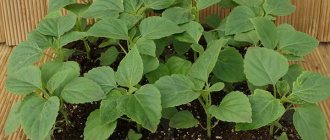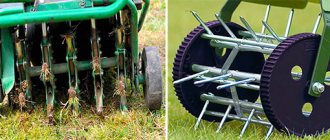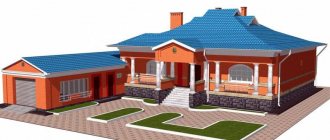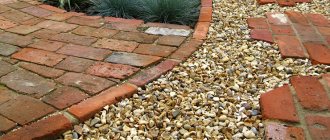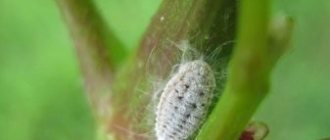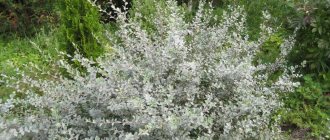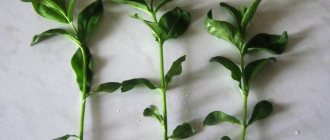Dichondra is an excellent plant for decorating flower beds or for creating green walls, cascades, arches, curtains, screens. Cascades of emerald or silver-green leafy shoots are shaped like a waterfall.
It is widely used in the design of gazebos, terraces, and verandas. It looks most expressive in hanging flowerpots. Some gardeners replace lawn grass with it - dichondra grows excellently in partial shade, hiding unsightly bare areas among trees, quickly forming a thick covering between the stones of the decorative path.
Comfortable wintering of dichondra
In order for the plant to grow well and look healthy, it is very important to provide it with conditions that best correspond to those established in the tropics.
This means that you will have to maintain the temperature and humidity levels at the proper level even in winter. To do this, you need to either move the dichondra into the house and place it in a warm place, continuing to actively take care of it: watering, fertilizing and fighting weeds. You just need to do everything a little less often than in the summer.
If you do not plan to keep dichondra in an apartment, it is recommended to do the following: before the onset of frost, cut off all shoots from the plant, carefully dig up the rhizome without shaking the earth, and move it to the basement. To prevent the roots from drying out over the winter, you can sprinkle them with a thick layer of moistened sand or cover them with wet peat.
With the arrival of spring, new stems with roots will appear on the mother plant. They need to be separated with a sharp knife and planted in separate pots. Or you can wait until a good above-zero temperature is established outside and transfer the dichondra directly to open ground. Feeding immediately is mandatory. After about 1 month, the plant will form a lush crown and begin to branch. You need to take care of it the same way as usual.
Practical recommendations
Dichondra loves high humidity, so after planting the flower it makes sense to purchase an air humidifier. If you have an air humidifier, growing dichondra will be significantly simplified, and its growth rate will accelerate. Also, while growing a plant, you need to regularly spray the plant against pests and parasites.
Dichondra can grow well both in the sun and in the shade, the main thing is that the environment is warm and humid, like in its homeland. Decorative indoor dichondra comes in two types: with green foliage and with light gray, silver foliage. The second variety looks the most impressive and decorative. Green dichondra develops quickly in both sunny, well-lit and shaded, semi-dark places. It should be noted that in a shaded area the leaves become noticeably larger. The silver foliage plant grows fastest in full sun, but a shady location is also a great option.
Large hanging wicker baskets with plant vines peeking out look beautiful. In summer, such a basket can be taken out to the balcony, veranda or terrace. However, as soon as it starts to get colder, the plant must be returned indoors, because dichondra cannot withstand sudden temperature changes.
Since the soil in Dichondra's homeland is quite poor, the plant can grow well in any soil. When growing indoors, you can plant the plant in regular garden soil purchased from a gardening store. It is not necessary to fertilize the soil before planting dichondra.
Dichondra is a very beautiful and unusual plant. Its stems really resemble a waterfall with silver streams of water flowing down. If you create comfortable conditions for the dichondra, close to the conditions in the flower’s homeland, the plant will delight the eye for a long time with the silvery threads of its shoots. This indoor plant will adequately decorate any, even the most sophisticated, interior. The main thing is to properly care for the plant and regularly shape the growing branches.
Dichondra silver waterfall
How does it reproduce
Dichondra can be grown in two ways - cuttings and seeds. The simplest method is cuttings, but it is used relatively rarely. According to the nature of its growth and main characteristics, the flower is a ground cover, so it can grow both in open ground and at home. The exception is Siberia, where the plant can only be grown at home.

Ampelous dichondra does not grow outdoors in Siberia
Ampelous dichondra can reproduce both by seeds and cuttings. The first method requires a lot of effort and patience, despite the fact that it is used relatively more often. This is explained by the fact that the plant is not very common among gardeners, so it is much easier to purchase seeds.
Propagation by seeds
It is best to plant seeds in pots in January or February. In this case, by the beginning of the summer season it will be possible to decorate the garden or balcony with the plant. Flower growers recommend preparing the soil for sowing in advance, into which the seeds should subsequently be sown to a depth of about 5 mm. After this, you need to sprinkle them with soil, water them thoroughly and wrap them with film. Such measures will help prevent moisture evaporation. The container with seeds must be placed in a warm place where the air temperature is at least 25 °C.
As soon as two main leaves appear on the sprouted shoots, they will need to be transplanted into separate pots, the diameter of which should not exceed 10 cm. Plants are transplanted into open ground after 8-9 weeks from the moment the shoots are planted in separate pots. It should be taken into account that planting should be carried out in heated soil.
In addition, when growing a flower from seeds, the following nuances should be taken into account:
- for sowing it is best to use light fertile soil, to which you must add sand;
- the depth of the growing container should be no more than 5 cm;
- After sowing the seeds, the container must be covered with film or glass;
- It is not recommended to sow seeds from January 15 to February 5.
Before planting in open ground, seedlings should be hardened off. Currently, flower growers who choose ampelous dichondra for planting give greater preference to growing from seeds.
Dichondra seeds
Propagation by cuttings
Stem layering is best suited for propagation by cuttings, since it is they that take root most easily if optimal conditions are created for them. The cuttings must be placed in a warm place, the air temperature should vary from 22 °C to 24 °C. As soon as roots appear on the cuttings, the shoot can be divided and then pressed in several places to the moistened soil.
Features and types
Dichondra is a perennial hanging plant; in nature it is found in well-moistened or wetlands. It grows long stems up to 1.5 meters, which often form a luxurious continuous carpet.
Climbing vines are densely strewn with leaves, which, depending on the variety, may differ in silver or bright green color. A characteristic feature of dichondra leaves is a silky edge.
The plant belongs to the decorative deciduous plants, so in summer its flowers are inconspicuous and dull. Green, white or yellow ones reach three millimeters in diameter.
Beginners, and not only others, will find this article useful on how to grow ursinia dill from seeds.
Popular types
Until now, no one has counted the exact number of dichondra species. The most popular among gardeners, landscape designers, and florists are only two of its varieties:
- "Emerald Falls"
- "Silver Falls"
Dichondra “Emerald Falls” does not have very long stems; its green leaves are 3 cm long. Throughout the summer, it may have rich yellow-green flowers. In its native New Zealand, where dichondra comes from, this beautiful hanging plant is considered a weed. In some countries it is used as a lawn covering that does not require mowing. Dichondra acts as an ideal material for creating garden sculptures; it successfully decorates walls and fences.
Dichondra "Emerald Falls" grows well in shaded areas, but it is also suitable for bright sunny areas. With regular care and spraying, the plant's leaf elasticity increases and its appearance becomes fresh.
Dichondra ampelous in garden design
“Emerald Falls” propagates well by seeds, and the perennial plant is also easy to care for.
The variety "Silver Falls" is so named because of the color of the leaves, which grow on rather long vines and look like silver. It is usually used as a potted plant to decorate rooms, loggias in apartments, verandas, gazebos and garden corners. This gorgeous plant does not require light, but if shaded, its decorative leaves may lose their attractiveness. Dichondra “Silver Falls” was awarded a medal for its beauty, ease of care and resistance to diseases; they really look like a silver waterfall or like threads of extraordinary beauty.
Due to the cold climate, this hanging plant in our country can decorate balconies and garden areas only at certain times, since the plant loves warmth. However, gardeners came out of the situation and came up with the idea of bringing dichondra home for the winter, thereby saving it from frost.
Types and varieties of Dichondra
Dichondra silver
This variety has silvery leaves and super-long shoots. But the bush is less lush than its counterparts.
Dichondra Emerald Falls
The leaves are round and medium in size. Plants grow more rapidly if they are located in sunny areas than those growing in the shade.
Ampelous dichondra
Dichondra ampelous is a creeping evergreen plant. It looks like a carpet. The root system of plants is located on the surface. The branches are low, barely reaching 15 cm in height. But in length they can grow up to a meter or two, which is significantly longer than that of Dichondra Emerald Falls or silver. Rooting occurs in a short period of time, since the roots are on the surface and form at the nodes.
Dichondras bloom in summer, the flowers are small. In general, they barely reach 2-3 mm. The colors of the flowers are varied. You can find flowers with pale greenish, purple or pale yellowish colors. The crop is pollinated by small insects.
Dichondra silver is most often grown. In the southern regions, where there are no severe frosts, the crop is cultivated as a perennial. In the middle zone, the plant is grown as an annual.
If you grow a plant at home, you can take it out to the balcony or veranda in the summer. In the north of the Russian Federation, dichondra is grown exclusively at home. Let's look at how to grow dichondra in more detail.
Planting dichondra in the garden
When to plant dichondra
In warm areas, dichondra is often used to form an alternative lawn due to its cold resistance and resistance to trampling. Planting the ampelous dichondra in open ground is done one and a half to two months after the emergence of seedlings. The approximate dates for planting seedlings for the southern regions are May, and for the northern regions - early or mid-June.
Dichondra grows well both in the sun and in the shade, but the variety with silver leaves is more light-loving. The plant is undemanding in terms of soil composition, but prefers loamy, well-drained soils with a pH of 6.6-8.

How to plant dichondra
If you want to use dichondra as a ground cover plant, keep in mind that it grows very slowly, so the seedlings need to be planted close to each other - at a distance of 10-15 cm. Make holes of such depth that the seedlings can fit in them along with a ball of earth, transfer the seedlings, fill the holes with soil, compact the surface and water.
Caring for dichondra in the garden
Garden dichondra, subject to simple care rules, can remain decorative for 5 to 7 years. Despite the fact that the plant is drought-resistant, try to water it regularly, but waterlogging the soil is not recommended. To avoid leaf burn, try to water the ground cover dichondra in the evenings. And do not forget about spraying the plant in the hot season - dichondra grows well in high air humidity.
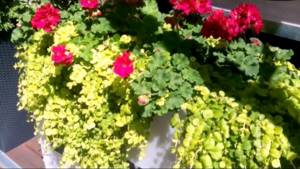
To achieve a high level of decorativeness of dichondra, it is necessary to apply complex mineral fertilizer with a predominance of potassium and nitrogen to the soil twice a month during the growing season.
After the appearance of eight leaves, it is advisable to pinch the stems of the dichondra, and then, as the plant grows and branches, the plant should be pruned - usually one pruning every two weeks is sufficient during the summer.
Weed control requires caution, since it is very easy to damage the roots of dichondra, located at a shallow depth
How to grow seedlings?
“Silver waterfall” seedlings are obtained using 2 methods:
- Cuttings. Up to 7 cuttings are prepared, which are placed in a container with water for rooting. After the roots have formed, transplantation into the ground is carried out.
- Germination of seeds. Planting material is introduced into containers with soil, and after 4 months the seedlings are transferred to the ground.
Landing dates
It is best to grow seedlings from seed. Since the bush is formed over 4 months, sowing of seed material begins from January 15 to March.
The specific period depends on climatic conditions: in the Southern regions, sowing begins early (in January), in Northern latitudes - closer to March.
Selection of container and soil
To grow dichondra, containers are used that must be filled with earthen mixture. To do this, take soil and fine sand in equal proportions.
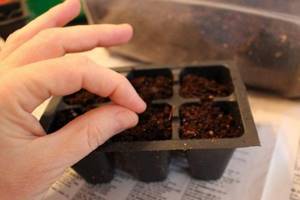
Seed preparation
To speed up the germination process and improve germination, prepare seed material. What can be done:
- use growth stimulants (Epin, etc.);
- soak in aloe juice;
- soak in hydrogen peroxide (1 tbsp per glass of water).
The soaking time for any solution is 50-60 minutes. Immediately after this, the planting material is planted.
Today you can find seeds on sale in granular form. In this case, soaking is not required.
Landing rules
Planting seeds for seedlings is carried out as follows:
- make 5 mm indentations in a container filled with soil mixture;
- introduce seeds;
- sprinkle a small layer of sand on top;
- use a spray bottle to irrigate the sand surface;
- cover the container with film or glass.
Peculiarities:
- before emergence of seedlings, the temperature regime is maintained at 24-25 degrees;
- the greenhouse effect is eliminated, so direct sunlight should not fall on the boxes;
- the first shoots form after 10 days;
- the cover is removed after the first shoots appear, after which the container can be moved to the windowsill on the sunny side.
Crop care
Dichondra grows slowly, so the first leaves appear only after one and a half to two months. During this period, it is necessary to pick the seedlings. That is, plant them in a more massive container. To do this, use boxes, flower pots and the like.
Gardeners most often deepen the subcotyledon a little, as aerial roots are actively developing. At the same time, the mustache also grows. In order for crops to grow faster, they are provided with a sufficient amount of light for 15 hours - additionally, phyto-, fluorescent lamps and the like are used.
At the beginning of development, the stems are actively growing, but they are still too weak. Therefore, it is necessary to stop their growth. To do this, add as loose soil as possible to the surface of the soil. Please note that the trunks break easily, so you need to add soil using a teaspoon and a toothpick, evenly distributing the soil throughout the container.
Seedling care
Rules of care:
- When the seedlings have 3 full leaves, fertilizer is required. Nitrogen fertilizers are used for these purposes. Dosage is 3 times less than for an adult plant.
- To make the foliage thicker, the ends are pinched. This is done at a distance of 10 to 15 cm along the stem as it grows.
- In order for the plant to quickly adapt to outdoor conditions, hardening is carried out. Namely, they take containers with seedlings out onto the balcony, loggia or street. Initially, an hour is enough, but every day the time spent in natural conditions is gradually increased.
- Be sure to monitor the soil moisture - it should not get wet or dry out.
How to plant and grow dichondra seedlings is described in detail in the following video:
Growing
The culture with beautiful silver leaves can be propagated by seeds or cuttings. The second option is possible if the house already has at least one plant.

Dichondra Silver Falls
Seed material is purchased at a flower shop. Dichondra ampelous growing from seeds is not difficult. Throughout the summer season it will decorate the area with its long shoots with silvery leaves.
Additional Information. In a natural environment, dichondra lashes reach 6-7 meters. At home, their length does not exceed 2 meters.
Features of growing from seeds
Sowing is done in boxes, then the grown bushes are transplanted into separate pots or onto a prepared area. The sowing procedure begins at the end of January.
Seed material is immersed in a solution of potassium permanganate for disinfection for 30-40 minutes. Then it is dried and placed in water to which a growth enhancer has been added.
The sowing process is carried out as follows:
- a container with low sides is filled with a substrate consisting of fertile soil and sand;
- the seeds are laid out on the surface;
- lightly sprinkle with sand;
- cover the box with plastic wrap.
Dichondra planting and care are not particularly difficult. Contain containers with crops in a warm and bright place, but without direct sunlight. The film is removed every day for a few minutes for ventilation. When the first shoots appear, the shelter is removed for good.
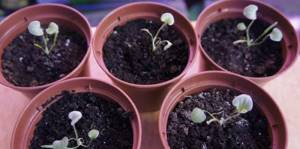
When the seedlings grow a little, they are transplanted into separate pots
Planting and care
The seedlings develop slowly. When the 3-4th true leaves appear, the crops dive. Young bushes are carefully removed from the ground and transplanted into separate pots.
Containers with creeping dichondra are placed in a well-lit place. With a lack of light, the shoots will begin to stretch. Care consists of watering the plants and carefully loosening the soil. The culture will be grateful for periodic spraying.
Note! You can grow beautiful dichondra bushes both in open and closed ground
Planting seedlings in flowerpots
Grown bushes are planted in larger pots. The procedure for transplanting dichondra seedlings is performed as follows:
- a drainage layer of small stones, broken bricks, and expanded clay is laid on the bottom of the container;
- pour loose, fertile soil;
- a depression is made in the middle into which the dichondra sprout is planted along with a lump of earth;
- water abundantly.
Excess water from the pan is poured out 10-15 minutes after irrigation.
Indoor cultivation and wintering
Dichondra is more demanding of care at home than when grown in open ground. The main problem is creating a sufficient level of illumination. Dichondra is very sensitive to the abundance of light and, with its lack, loses its visual appeal.
In order for the plant to feel comfortable and delight the eye with lush greenery, it needs bright diffused lighting for at least 12 hours a day. In the summer, this can be easily achieved by moving the indoor beauty outside. In winter, the plant should be placed as close to the windows as possible and additional lighting should be provided with a phytolamp.
Decorative indoor trees in pots for the home
Another nuance that you should definitely pay attention to when growing dichondra in a room is that there is a sufficient volume of the pot for the normal development of the root system. In open ground in winter, the roots of dichondra “sleep”
When kept indoors, renewal of green mass and growth of the root system occurs constantly, so the plant requires regular replanting. A signal that it is time to transplant the dichondra into a larger container is the germination of roots through the drainage holes of the pot. The sprouted roots are cut off, and the plant is carefully transplanted into a new pot using a simple transfer method.
Indoor keeping often serves as a solution to how to preserve dichondra in winter. When autumn comes, hanging plants are moved indoors, where they are provided with further care. Dichondra placed in a room for the winter requires more frequent spraying, since in heated rooms the air humidity level is much lower than even in the hottest weather outside.
Plants grown in open ground tolerate changes in growing conditions more difficult than those grown in trusses. For this reason, most gardeners prefer “cold” storage of such specimens in the basement. The plant is dug up along with a lump of earth, all shoots are removed to the base. In the spring, when warm weather sets in, the rhizome is planted back into the ground.
In the first season, dichondra does not produce a very abundant increase in green mass. The most decorative appearance is achieved in the second or even third year of cultivation, depending on the conditions created for the plant. For this reason, overwintering mature plants indoors or in the basement is preferable to growing annuals from seed each year.
How to care for dichondra?
In order for the plant to please its owners, it is necessary to learn the main rules of care, which are completely simple. The main requirement is to carry out all activities in the early morning or evening, when there is no exposure to the sun. This is especially true for the procedure of watering and fertilizing.
Watering
“Silver Falls” does not tolerate high humidity, but it can also die in dry conditions, so follow these rules:
- You need to water the plant after a slight dry crust has formed (the amount of watering depends on air humidity);
- the soil should not be wet;
- It is unacceptable for water (even clean water) to get on the leaf part in sunny weather, as the plant will be burned;
- Little water is needed for irrigation.
Dichondra belongs to the swamp type flora, but mainly for the green part of the plant. That is why it does not tolerate high humidity in the root system, but requires moisture in the leaves. This involves frequent watering of the leaves and stems with a spray bottle.
Feeding
Fertilizers are applied for six months - from spring to autumn. Fertilizing is done every week, fertilizers are alternated (nitrogen fertilizing with phosphorus-potassium agents).
A prerequisite is to wash the leaf and stem parts of the plant after applying fertilizer.
Trimming
Pruning is necessary not only to create a beautiful shape - in order for the dichondra to actively branch in spring, such a procedure is also necessary. To do this, shorten the stems from above, cut off damaged elements and shoots that stand out from the general mass.
Pruning is carried out with sharp pruning shears. If you do not plan to create a specific decorative element, then you can not trim the vines throughout the summer, but let them grow like vines on supports.
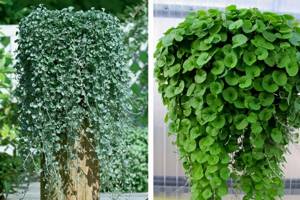
Disease and pest control
Dichondra is rarely susceptible to disease, but it is afraid of root rot. The reason for this is the intolerance of moisture by the delicate root system, which results in the formation of rot on the roots. To avoid this, monitor the moisture level in the soil - do not water excessively.
Among the pests the following representatives are noted:
- Nematodes are worms that live in high humidity levels. Defeat by them leads to mutation and further inevitable death of the plant. There are no treatment methods, so you will have to get rid of the “silver waterfall” and even the soil where the vine grew.
- Whitefly, flea beetle, aphid. These insects rarely inhabit dichondra, but if this happens, insecticides sold in garden stores are used to combat them.
Preventive measures help prevent plant disease and prevent pest damage. What do we have to do:
- periodically carry out mulching;
- carry out weeding;
- do not flood the soil with water;
- apply fertilizers;
- sometimes treat with insecticidal agents - “Iskra”, “Aktellik”, “Aktara”.
Features of winter care
Dichondra is a perennial plant, but in harsh climates it is grown as an annual. But in vain, because for wintering you can use indoor conditions. To do this, the “silver waterfall” should not be planted in open ground - it is enough to plant the flower in pots that are taken outside in the summer.
If the room is cool (on the loggia, etc.), then you need to limit watering and fertilizing. Under warm conditions, the frequency of irrigation of foliage and stems increases. Especially if heating radiators are installed that dry out the air.
There is another way to preserve dichondra in the form of shoots - in the basement. To do this you need:
- cut off shoots;
- uproot the plant with its rhizome and earthen clod;
- put in a box with sand;
- sprinkle with peat;
- moisturize.
In the spring, new shoots are already formed on the shoots, which are subjected to cuttings, after which they are planted in open ground. The bush that was dug up is transplanted to its old place in March.
Growing from seeds
You can propagate ampelous dichondra in two ways:
- propagation by stem cuttings, shoots;
- growing from seeds.

Due to the fact that this plant is just beginning to gain popularity among gardeners, acquiring cuttings or shoots is quite problematic. Therefore, it is better to stop at growing it from seeds. In order to grow this flower yourself at home from seeds, you need to properly prepare and stock up on everything you will definitely need during the work. The first thing to do is prepare the soil and container. It is better to choose pots for planting dichondra that are narrow, oblong, preferably made of wood. It will be convenient to cover such a container with glass on top. In order to grow dichondra from seeds, you should stock up on a lot of patience, because you have to admit that this is quite hard and painstaking work. For soil, it is better to choose a mixture of fertile soil and sand, loamy, with a weak or even neutral acidity content. Before pouring soil into the pot, you should put drainage on its bottom, which can be made of large pebbles, broken shards and sand. This layer should be 1.5 cm.
Before planting seeds in prepared soil, they must be soaked in a growth stimulator solution. This could be “Gibberellin Hormone”, “Epin-Extra” or “Kornevin”, however, any that is designed to improve vegetative function and increase the percentage of seeds rising. This way they germinate much faster. It is better to sow dichondra in the soil in the middle of winter (late January to mid-February). This is directly related to the fact that dichondra, which is grown by seeds, very slowly forms seedlings at the primary stage of vegetative propagation. The decorative effect of the plant, which gardeners expect to achieve as a result, occurs no earlier than after 3 months. Therefore, it is necessary to plant it in advance so that the seedlings have time to form properly. Seeds should be planted to a depth of no more than 5 mm. You can simply scatter them on the soil and carefully cover them with a small layer of soil. After planting, the soil must be moistened. but without watering it, but simply spraying water over it with a spray bottle.
It is very important to monitor the air temperature in the room at first; it should be quite high, at least 21°C. It will be much better for the plant if, after sowing the seeds, a greenhouse effect is created for it by covering the container with polyethylene or glass, leaving a small hole for fresh air to penetrate
Dichondra should be watered regularly, but do not overdo it; the seeds should not float. A small amount of growth stimulator can be added to irrigation water. With good care and the right conditions, the first shoots can be observed after 1-2 weeks. After about a month, the germinated seedlings can be planted into separate pots.
Reproduction
You can get new dichondras using layering, cuttings or seeds. If this flower is not yet in the house or garden, then seeds are used for propagation, which are sown directly in open ground or using seedlings.
By layering
This method is the simplest and most convenient.
Before planting, first prepare the area, carefully dig it up and loosen it, remove weeds and old roots, and water it. Then the dichondra shoot needs to be sprinkled with soil. In a week it will take root and form new shoots. Another month later, the resulting shoot is cut off , dug up along with the roots and planted in a permanent place.
The holes for planting must be at least 3 cm deep so that the roots and part of the shoot can fit into them. When combining dichondra with other crops, the distance between seedlings should be at least 35 cm.
Growing from seeds
Seeds should be sown at the end of January - beginning of February if you plan to plant seedlings. Seeds are sown in open ground with the onset of warm weather - at the end of May, mid-June (depending on the region). The instructions are as follows:
- First of all, the seeds are soaked in water, adding a growth stimulant.
- For seedlings, small pots are used, 2-3 seeds are placed in each pot. The containers are filled with peat substrate, which is disinfected in advance and spilled with sodium humate.
- The seeds are sown to a depth of 0.8 cm and then covered with polyethylene or glass, leaving a small hole for ventilation.
Seedlings are grown in a warm, sunny place, with a temperature not lower than 22-24 degrees.
Cuttings
The cutting procedure is carried out in the spring , and stem cuttings are used for propagation.
Such planting material quickly takes root. To do this, you need to create comfortable conditions: the room temperature should not be lower than 22-24 degrees. The length of the shoots should be 5-6 centimeters. When the roots appear, the shoot needs to be divided and then pressed into pre-moistened soil in several places.
Dichondra does not tolerate frequent transplants. The procedure is carried out only when the roots no longer fit in the flowerpot.
Dichondra
More recently, a spectacular, decorative-deciduous ampelous plant called Dichondra argentea, Dichondra repens, has appeared in home floriculture.
The first time it was seen by a large number of flower growers was at the International Exhibition “Flowers 2004”. Then this plant received a silver medal. This plant, of which there are approximately 10 species, is related to the bindweed family. In the wild, it can be found in subtropical and tropical rain forests, as well as swamps of Australia, East Asia and America.
This ampelous plant is not capricious and undemanding in care. Dichondra has thin lashes, the length of which can reach 2 meters (and in places with a mild climate and a long summer period they grow up to 6 meters).
These shoots, which contain many very small leaves of rich green or silver color, can spread along the surface of the ground or hang down, falling over the edge of the pot.
Its flowers do not have any special decorative value.
This flower has been recognized as one of the best decorative foliage plants that can decorate hanging baskets or flowerpots. It is popular among phytodesign masters, as its unusually spectacular leaves serve as an excellent background for other beautiful flowering plants.
Also, in a winter garden, with the help of dichondra, it is quite possible to create the effect of a waterfall, a running stream or a lake. The branches falling down, touching the surface of the earth, take root. This flower then grows as a ground cover plant.
For growing at home, 2 types of this plant are most often used, namely:
Illumination
Dichondra with green leaves can grow well both in sunny and shaded places. Moreover, in the shade it grows larger leaves. A plant with silver leaves prefers sunny places, but also feels good in partial shade.
Temperature
For normal growth and development, such a flower requires a temperature ranging from 18 to 25 degrees. For dichondra, it is undesirable for the temperature to be less than 10 degrees.
Humidity
Can grow at any air humidity. But it is worth considering that in high humidity the plant feels much better. Relates well to moisture from a sprayer.
How to water
Since in the wild this plant prefers damp places, it should be watered systematically. However, a good drainage layer in the pot is simply necessary.
It was noted that when grown as a ground cover plant, dichondra died in places where there was stagnation of water. But it has resistance to drying out of the earthen coma.
Apparently, it is damaged by excess moisture combined with fairly cool nights.
Top dressing
Fertilizing is carried out 2 times a month during the period of intensive growth with conventional fertilizers. During wintering in an apartment, you should not apply fertilizer to the soil.
Trimming
In order for the crown to be thicker, the plant requires systematic pruning. When moving dichondra indoors for the winter, long shoots must be trimmed.
Dichondra care at home
Growing conditions
Caring for dichondra at home is simple, as is caring for other decorative foliage ampels - chlorophytum, creeping ficus, rooting ficus, asparagus, saxifrage or zebrina, but before you grow dichondra at home, you need to study its botanical characteristics and preferences . The level of illumination for a dichondra is determined by the color of its leaves: for plants with a green color, both brightly lit places and partial shade, and even shade are suitable, but silver-leaved dichondras are more light-loving and will not grow in the shade. The temperature regime requires a level of 18-25 ºC at any time of the year, but if the dichondra is in an unheated room in winter, the temperature in it should not fall below 10 ºC, otherwise the plant may die. Dichondra grows poorly in conditions of constantly high temperatures.
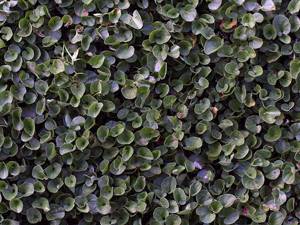
Dichondra can grow even at low air humidity, but daily spraying will benefit it - the growth of green mass will increase by 25%. If you spray dichondra twice a day (morning and evening), the process of formation of deciduous mass will be doubled. Dichondra especially needs spraying in the winter months if its wintering takes place at temperatures above 18 ºC.
As for watering, it should be plentiful, but the plant does not tolerate stagnant moisture in the roots, so the pot must have a thick layer of drainage material. If there is a long break between waterings and the substrate in the pot with the plant dries out, the dichondra can live without water for some time, and after watering it will quickly recover.
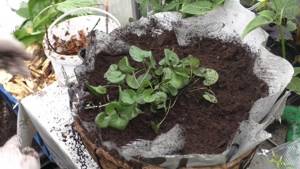
Twice a month from April to September, fertilizer for decorative deciduous indoor plants, for example, Ideal, should be applied under the dichondra. In addition, once a week, to accelerate the formation of leaf mass, you can feed dichondra with Agricola. In winter, if the plant is in a cool room, it does not need feeding.
- Autumn pruning of ornamental shrubs
Trimming
To form a lush crown of an ampelous dichondra, it needs to be pinched and trimmed. The plant needs pruning and in preparation for wintering. To enhance tillering, the ends of the shoots are pinched, and when they become too long, they are cut off. In culture, dichondra whips can reach a length of two meters, and in warm climates they grow up to six. Landscape designers, with the help of dichondra, create an imitation of a running stream in the garden - it looks impressive, especially since the flowing stems, having reached the ground, easily take root, turning the hanging plant into a ground cover. It’s up to you to trim the dichondra’s lashes or let them grow, but it’s still advisable to pinch the ends of the shoots to enhance bushiness.
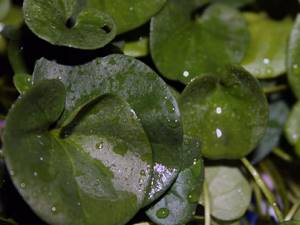
Accommodation
Dichondra grows equally well both in the garden and in indoor culture. Superficial roots formed in the internodes of the stems take root easily, forming a solid green or silver carpet that does not lose its color even in winter. And dichondra, grown as an ampel, flows down like a silver or green waterfall. Pots or baskets with dichondra decorate homes, terraces, verandas, balconies and loggias.
Pests and diseases
Dichondra is resistant to any diseases and harmful insects, since it is essentially a weed, and if you follow the conditions of its maintenance, then nothing will harm the health of the plant. The only danger that can threaten dichondra are nematodes - microscopic worms that develop in a humid environment, causing mutations that lead to the death of the plant. Moreover, nematodes affect both garden and indoor crops. It is useless to fight them, so it is better to immediately destroy the plants and the soil in which they grew.
In addition to nematodes, in rare cases, dichondra can be disturbed by whiteflies, aphids and fleas. These pests are destroyed with acaricides, and to prevent these problems from arising, the following preventive measures can be used:
- do not mulch the area where dichondra grows, and remove weeds by hand;
- if the dichondra planting has turned into a dense carpet, reduce the number of waterings;
- do not exceed a reasonable dose of nitrogen fertilizers.
